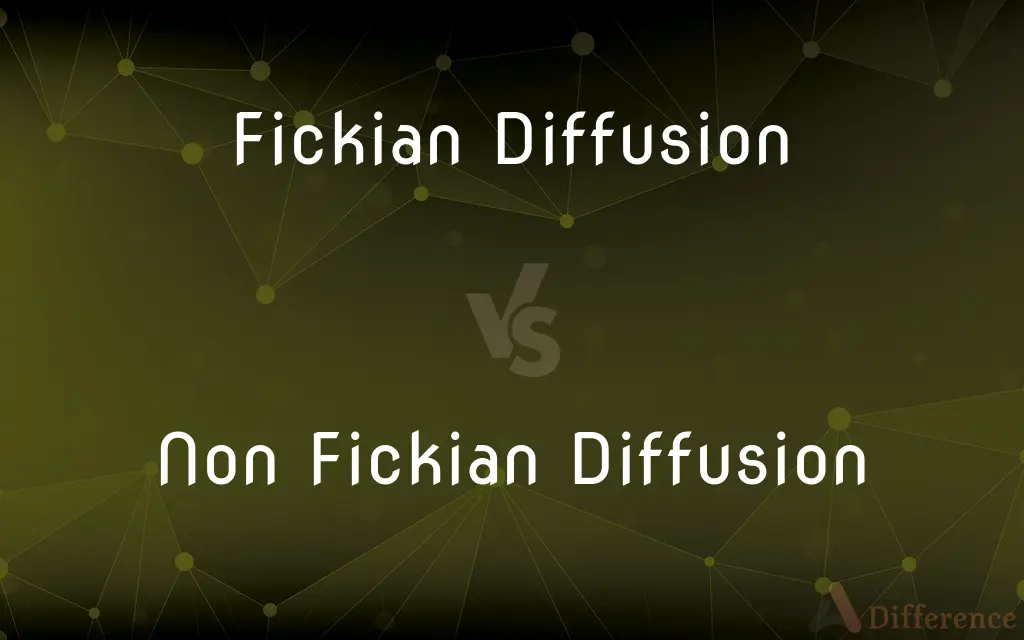Fickian Diffusion vs. Non Fickian Diffusion — What's the Difference?
Edited by Tayyaba Rehman — By Fiza Rafique — Published on December 30, 2023
Fickian Diffusion relates to concentration-driven processes; Non Fickian Diffusion involves non-linear, often time-dependent diffusion.

Difference Between Fickian Diffusion and Non Fickian Diffusion
Table of Contents
ADVERTISEMENT
Key Differences
Fickian Diffusion and Non Fickian Diffusion represent distinct types of molecular dispersion mechanisms in materials. Fickian Diffusion is based on Fick's laws, which describe the diffusion process as being driven solely by concentration gradients. This linear relation signifies that the rate of diffusion is directly proportional to the concentration gradient, making it a straightforward process to understand.
On the contrary, Non Fickian Diffusion, sometimes termed anomalous diffusion, does not strictly follow Fick's laws. This type of diffusion arises in systems where the diffusion rate isn't just determined by concentration gradients. Factors such as polymer relaxation or other molecular phenomena can influence the diffusion process, making it deviate from the linear relationship described by Fick's laws.
In practice, Fickian Diffusion is observed in simpler systems, like the diffusion of a solute in a solvent. The concentration-driven process ensures that the solute molecules spread out to equalize concentration throughout the solvent. Non Fickian Diffusion, however, is commonly seen in complex systems, especially in polymer science. Here, the diffusion of a solvent into a polymer may not be just concentration-driven; the relaxation or movement of polymer chains can also play a role.
To summarize, while Fickian Diffusion provides a foundational understanding of diffusion in many systems based on concentration gradients, Non Fickian Diffusion introduces complexities, accounting for additional factors influencing the diffusion process. Recognizing the difference between these two types of diffusion is crucial in material science, especially when designing or analyzing materials where molecular dispersion plays a significant role.
Comparison Chart
Basis of Definition
Fick's laws of diffusion.
Deviation from Fick's laws due to other influences.
ADVERTISEMENT
Driving Factor
Concentration gradients.
Not solely concentration gradients; often involves time-dependent factors or molecular interactions.
Complexity
Simpler, linear relationship.
Complex, non-linear.
Typical Observation
Solute diffusion in solvents.
Often in polymer systems.
Rate Dependence
Rate depends on concentration gradient.
Rate can be influenced by factors other than concentration gradients.
Compare with Definitions
Fickian Diffusion
Simplified diffusion not influenced by external molecular interactions.
Oxygen moving through a metal lattice is an example of Fickian Diffusion.
Non Fickian Diffusion
Anomalous diffusion frequently observed in heterogeneous systems.
The release of drugs from certain complex matrices involves Non Fickian Diffusion.
Fickian Diffusion
Linear molecular dispersion process.
The consistent rate of sugar dissolving in tea is due to Fickian Diffusion.
Non Fickian Diffusion
Diffusion deviating from Fick's linear laws.
The absorption of solvents by certain polymers showcases Non Fickian Diffusion.
Fickian Diffusion
Diffusion described by Fick's laws based on concentration gradients.
The spread of ink in water follows Fickian Diffusion.
Non Fickian Diffusion
Diffusion often linked to polymer chain dynamics or external interactions.
The hydration of specific polymers is governed by Non Fickian Diffusion due to chain relaxation.
Fickian Diffusion
Standard model of diffusion in homogeneous systems.
Gases diffusing in air usually exhibit Fickian Diffusion.
Non Fickian Diffusion
Complex diffusion influenced by factors other than concentration.
The spread of water in a swelling gel can exhibit Non Fickian Diffusion.
Fickian Diffusion
Concentration-driven diffusion mechanism.
Perfume spreading in a room demonstrates Fickian Diffusion.
Non Fickian Diffusion
Often time-dependent and nonlinear molecular dispersion.
Diffusion in certain nanomaterials might display Non Fickian Diffusion characteristics.
Common Curiosities
What drives Fickian Diffusion?
Fickian Diffusion is driven by concentration gradients.
Why is Non Fickian Diffusion considered anomalous?
It deviates from the linear laws of Fick, often influenced by other factors.
What makes Non Fickian Diffusion complex?
It can involve time-dependent factors or molecular interactions, not just concentration gradients.
Is Fickian Diffusion always linear?
Yes, it's based on a linear relationship between diffusion rate and concentration gradient.
Are polymer systems more likely to exhibit Fickian or Non Fickian Diffusion?
Polymer systems often exhibit Non Fickian Diffusion due to chain dynamics.
In which systems is Fickian Diffusion commonly observed?
It's typically seen in simpler systems like solute diffusion in solvents.
Share Your Discovery

Previous Comparison
AFM vs. STM
Next Comparison
Sale vs. Agreement to SellAuthor Spotlight
Written by
Fiza RafiqueFiza Rafique is a skilled content writer at AskDifference.com, where she meticulously refines and enhances written pieces. Drawing from her vast editorial expertise, Fiza ensures clarity, accuracy, and precision in every article. Passionate about language, she continually seeks to elevate the quality of content for readers worldwide.
Edited by
Tayyaba RehmanTayyaba Rehman is a distinguished writer, currently serving as a primary contributor to askdifference.com. As a researcher in semantics and etymology, Tayyaba's passion for the complexity of languages and their distinctions has found a perfect home on the platform. Tayyaba delves into the intricacies of language, distinguishing between commonly confused words and phrases, thereby providing clarity for readers worldwide.
















































